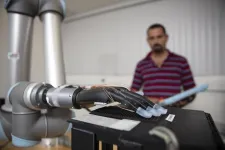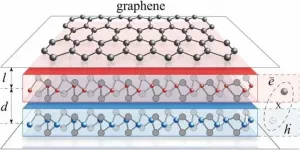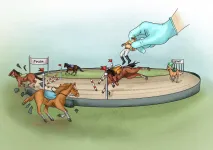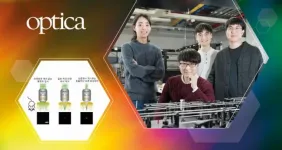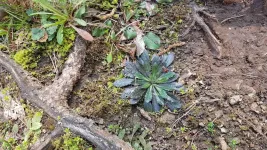(Press-News.org) Each fingertip has more than 3,000 touch receptors, which largely respond to pressure. Humans rely heavily on sensation in their fingertips when manipulating an object. The lack of this sensation presents a unique challenge for individuals with upper limb amputations. While there are several high-tech, dexterous prosthetics available today - they all lack the sensation of "touch." The absence of this sensory feedback results in objects inadvertently being dropped or crushed by a prosthetic hand.
To enable a more natural feeling prosthetic hand interface, researchers from Florida Atlantic University's College of Engineering and Computer Science and collaborators are the first to incorporate stretchable tactile sensors using liquid metal on the fingertips of a prosthetic hand. Encapsulated within silicone-based elastomers, this technology provides key advantages over traditional sensors, including high conductivity, compliance, flexibility and stretchability. This hierarchical multi-finger tactile sensation integration could provide a higher level of intelligence for artificial hands.
For the study, published in the journal Sensors, researchers used individual fingertips on the prosthesis to distinguish between different speeds of a sliding motion along different textured surfaces. The four different textures had one variable parameter: the distance between the ridges. To detect the textures and speeds, researchers trained four machine learning algorithms. For each of the ten surfaces, 20 trials were collected to test the ability of the machine learning algorithms to distinguish between the ten different complex surfaces comprised of randomly generated permutations of four different textures.
Results showed that the integration of tactile information from liquid metal sensors on four prosthetic hand fingertips simultaneously distinguished between complex, multi-textured surfaces - demonstrating a new form of hierarchical intelligence. The machine learning algorithms were able to distinguish between all the speeds with each finger with high accuracy. This new technology could improve the control of prosthetic hands and provide haptic feedback, more commonly known as the experience of touch, for amputees to reconnect a previously severed sense of touch.
"Significant research has been done on tactile sensors for artificial hands, but there is still a need for advances in lightweight, low-cost, robust multimodal tactile sensors," said Erik Engeberg, Ph.D., senior author, an associate professor in the Department of Ocean and Mechanical Engineering and a member of the FAU Stiles-Nicholson Brain Institute and the FAU Institute for Sensing and Embedded Network Systems Engineering (I-SENSE), who conducted the study with first author and Ph.D. student Moaed A. Abd. "The tactile information from all the individual fingertips in our study provided the foundation for a higher hand-level of perception enabling the distinction between ten complex, multi-textured surfaces that would not have been possible using purely local information from an individual fingertip. We believe that these tactile details could be useful in the future to afford a more realistic experience for prosthetic hand users through an advanced haptic display, which could enrich the amputee-prosthesis interface and prevent amputees from abandoning their prosthetic hand."
Researchers compared four different machine learning algorithms for their successful classification capabilities: K-nearest neighbor (KNN), support vector machine (SVM), random forest (RF), and neural network (NN). The time-frequency features of the liquid metal sensors were extracted to train and test the machine learning algorithms. The NN generally performed the best at the speed and texture detection with a single finger and had a 99.2 percent accuracy to distinguish between ten different multi-textured surfaces using four liquid metal sensors from four fingers simultaneously.
"The loss of an upper limb can be a daunting challenge for an individual who is trying to seamlessly engage in regular activities," said Stella Batalama, Ph.D., dean, College of Engineering and Computer Science. "Although advances in prosthetic limbs have been beneficial and allow amputees to better perform their daily duties, they do not provide them with sensory information such as touch. They also don't enable them to control the prosthetic limb naturally with their minds. With this latest technology from our research team, we are one step closer to providing people all over the world with a more natural prosthetic device that can 'feel' and respond to its environment."
INFORMATION:
Study co-authors are Rudy Paul, FAU Department of Ocean and Mechanical Engineering; Aparna Aravelli, Ph.D.; Ou Bai, Ph.D.; and Leonel Lagos, Ph.D., PMP, all with Florida International University; and Maohua Lin, Ph.D., FAU Department of Ocean and Mechanical Engineering.
The research was supported by the National Institute of Biomedical Imaging and Bioengineering of the National Institutes of Health (NIH) and the National Institute of Aging of the NIH, the National Science Foundation, the Department of Energy and pilot grants from the FAU Stiles-Nicholson Brain Institute and FAU I-SENSE.
About FAU's College of Engineering and Computer Science:
The FAU College of Engineering and Computer Science is internationally recognized for cutting edge research and education in the areas of computer science and artificial intelligence (AI), computer engineering, electrical engineering, bioengineering, civil, environmental and geomatics engineering, mechanical engineering, and ocean engineering. Research conducted by the faculty and their teams expose students to technology innovations that push the current state-of-the art of the disciplines. The College research efforts are supported by the National Science Foundation (NSF), the National Institutes of Health (NIH), the Department of Defense (DOD), the Department of Transportation (DOT), the Department of Education (DOEd), the State of Florida, and industry. The FAU College of Engineering and Computer Science offers degrees with a modern twist that bear specializations in areas of national priority such as AI, cybersecurity, internet-of-things, transportation and supply chain management, and data science. New degree programs include Masters of Science in AI (first in Florida), Masters of Science in Data Science and Analytics, and the new Professional Masters of Science degree in computer science for working professionals. For more information about the College, please visit eng.fau.edu.
About Florida Atlantic University:
Florida Atlantic University, established in 1961, officially opened its doors in 1964 as the fifth public university in Florida. Today, the University serves more than 30,000 undergraduate and graduate students across six campuses located along the southeast Florida coast. In recent years, the University has doubled its research expenditures and outpaced its peers in student achievement rates. Through the coexistence of access and excellence, FAU embodies an innovative model where traditional achievement gaps vanish. FAU is designated a Hispanic-serving institution, ranked as a top public university by U.S. News & World Report and a High Research Activity institution by the Carnegie Foundation for the Advancement of Teaching. For more information, visit http://www.fau.edu.
New data on macaw movements gathered by the Texas A&M University College of Veterinary Medicine & Biomedical Sciences' (CVMBS) The Macaw Society has the potential to greatly improve conservation strategies for the scarlet macaw, as well as similar species of large parrots.
While the overall conservation status of the scarlet macaw is listed as "least concern" by the International Union for Conservation of Nature, the species is declining across much of Central America and in other parts of its range in South America. The species also shares its habitat with numerous endangered species and influences the ecosystems in which ...
The concept of interoperability describes the ability of different systems to communicate. This is a major challenge in biomedical research, and in particular, in the field of personalised medicine, which is largely based on the compilation and analysis of numerous datasets. For instance, the COVID-19 pandemic has shown that even when the technical, legal and ethical constraints are lifted, the data remain difficult to analyse because of semantic ambiguities. Under the auspices of the Swiss Personalized Health Network (SPHN) and in close collaboration with representatives from all five Swiss university ...
Superconductivity is a physical phenomenon where the electrical resistance of a material drops to zero under a certain critical temperature. Bardeen-Cooper-Schrieffer (BCS) theory is a well-established explanation that describes superconductivity in most materials. It states that Cooper pairs of electrons are formed in the lattice under sufficiently low temperature and that BCS superconductivity arises from their condensation. While graphene itself is an excellent conductor of electricity, it does not exhibit BCS superconductivity due to the suppression of electron-phonon interactions. This is also the reason that most 'good' conductors such as gold and copper are 'bad' ...
The corona pandemic has ensured that the term "mRNA" is now also known to a large public beyond laboratories and lecture halls. However, the molecule is much more than an important component of a successful vaccine against the SARS-CoV-2 virus. "mRNAs are a central component of all living things on our planet. Without them life as we know it would not function," says Elmar Wolf.
Wolf is a professor for tumour system biology at the Department of Biochemistry and Molecular Biology at the University of Würzburg. With his research team, he has now deciphered new details about the formation of mRNA which provide novel insights into how a fundamental process inside cells works: the transcription. The team ...
A team of researchers, affiliated with UNIST has succeeded in developing a new optical microscope technology, capable of deeper imaging beyond the biological tissues. This breakthrough has been led by Professor Jung-Hoon Park and his research team in the Department of Biomedical Engineering at UNIST.
Optical imaging technology has emerged as an essential research tool for biomedical studies due to its high resolution and good tomography capability. However, the limited penetration depth of the optical microscope makes it difficult to observe biological tissues of more than 100 μm thickness. This is because strong light scattering, caused by various components ...
New York, NY--July 13, 2021--The past decade has witnessed scandal after scandal over private images maliciously or accidentally made public. A new study from computer scientists at Columbia Engineering reveals what may be the first way to encrypt personal images on popular cloud photo services, such as those from Google, Apple, Flickr and others, all without requiring any changes to -- or trust in -- those services.
Smartphones now make it easy for virtually everyone to snap photos, with market research firm InfoTrends estimating that people now take more than a trillion photos each year. The limited ...
A new study reveals the strategies that stop bandits from illegally fishing in Australian waters--but warns there is a cost to the region's poorer countries.
Co-author Dr Brock Bergseth, from the ARC Centre of Excellence for Coral Reef Studies at James Cook University, said poachers are simply following the recurring history of human fishing: intensively fish and devastate local resources, then move further afield to--in these cases--fish illegally or poach in other countries' waters.
"Millions of people rely on fish and seafood and when offered no alternative choice, will chose banditry and illegal fishing ...
A new method of DNA testing on cocoa beans could revolutionise the chocolate industry, offering consumers greater reassurance about the origins and ethics of their beloved confectionery, and giving the global cocoa industry a precision tool to help end slavery and child labour.
Researchers from the University of Bath, University of the West of England, and Surrey Business School have proven a low-cost method which compares DNA in chocolate products to the cocoa when it is farmed. This means cocoa can be reliably traced back from an individual chocolate bar to the specific farms which cultivated the cocoa in it, a major advance on current fairtrading, certification and sustainability practices.
"This has the potential to ...
What the fruit fly is to zoologists, the thale cress is to botanists. The widespread herb with the botanical name Arabidopsis thaliana serves them as a model organism from which knowledge can be gained for other plants. It is therefore extremely well researched - also genetically. For example, it is now known that the genetic material of Arabidopsis thaliana (its genome) comprises around 125 million base pairs. It's like having a Lego manual in front of you that is 125 million letters long and contains everything you need to know to build an Arabidopsis plant.
Similar to humans, different Arabidopsis specimens are generally not genetically identical. If you were to compare the construction manual of all plants of this species, you would encounter differences in about 10 million places, ...
Dr. Iair Arcavi, a Tel Aviv University researcher at the Raymond and Beverly Sackler Faculty of Exact Sciences, participated in a study that discovered a new type of stellar explosion - an electron-capture supernova. While they have been theorized for 40 years, real-world examples have been elusive. Such supernovas arise from the explosions of stars 8-9 times the mass of the sun. The discovery also sheds new light on the thousand-year mystery of the supernova from A.D. 1054 that was seen by ancient astronomers, before eventually becoming the Crab Nebula, that we know today.
A supernova is the explosion of a star following a ...
